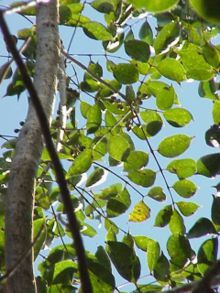| Bursera | |
|---|---|

| |
| Bursera simaruba | |
| Scientific classification | |
| Kingdom: | Plantae |
| Clade: | Tracheophytes |
| Clade: | Angiosperms |
| Clade: | Eudicots |
| Clade: | Rosids |
| Order: | Sapindales |
| Family: | Burseraceae |
| Genus: | Bursera Jacq. ex L.[1] |
| Type species | |
| Bursera simaruba | |
| Species | |
|
About 100, see text. | |
| Synonyms | |
|
Elaphrium Jacq. | |
Bursera is a genus with about 100 described species[2] of flowering shrubs and trees varying in size up to 25 m (82 ft) high. It is the type genus for Burseraceae. The trees are native (often for many species endemic) to the Americas, from the southern United States south through to northern Argentina, in tropical and warm temperate forest habitats. It is named after the 17th-century Danish botanist Joachim Burser.
Several Mexican species (such as B. aloexylon and B. delpechiana) produce a type of wood known as linaloe (from Mexican Spanish lináloe, from Latin lignum aloes, lit. 'wood of the aloe' or 'aloeswood').[3] They contain the aromatic oil linalool.
A number of species from tropical Asia were once included in this genus, but are now treated in the genus Protium.
The Bursera graveolens tree (also known as Palo Santo) belongs to this genus.
- ^ "Genus: Bursera Jacq. ex L." Germplasm Resources Information Network. United States Department of Agriculture. 2007-10-05. Archived from the original on 2009-05-07. Retrieved 2010-11-18.
- ^ Becerra, Judith X.; D. Lawrence Venable (2008). Rees, Mark (ed.). "Sources and Sinks of Diversification and Conservation Priorities for the Mexican Tropical Dry Forest". PLOS ONE. 3 (10): e3436. Bibcode:2008PLoSO...3.3436B. doi:10.1371/journal.pone.0003436. PMC 2562985. PMID 18927613.
no
- ^ "linaloe". Merriam-Webster.com Dictionary. Merriam-Webster.